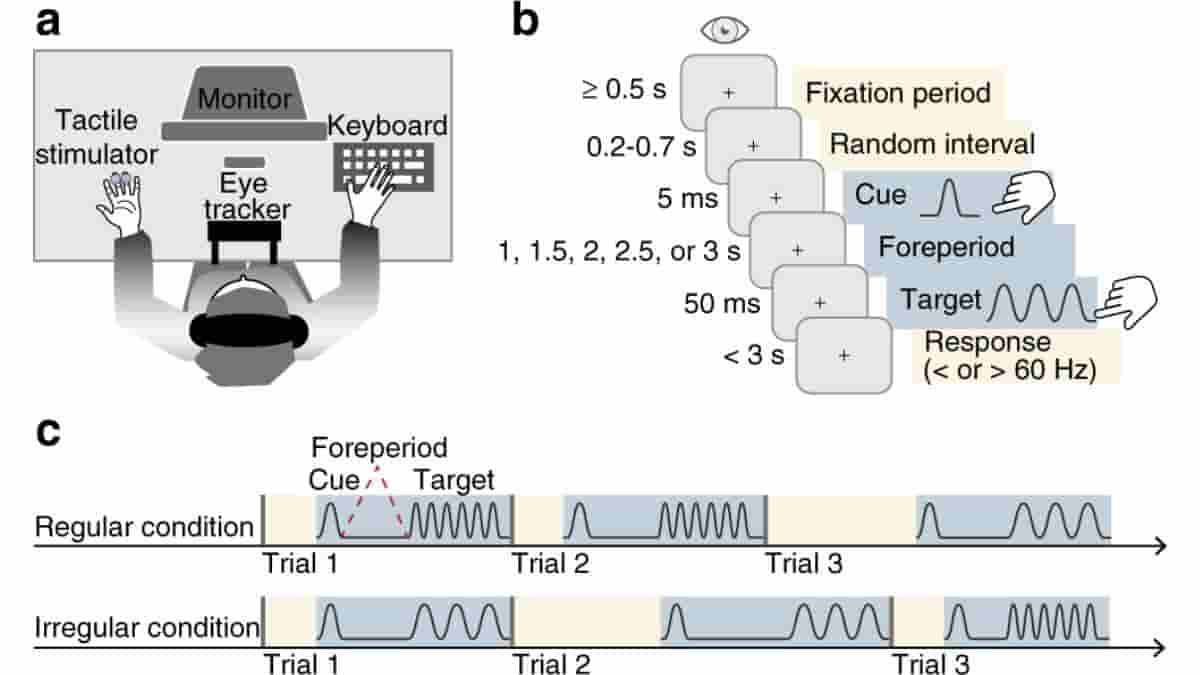Tiny eye movements can be used as an index of humans’ ability to anticipate relevant information in the environment independent of the information’s sensory modality, a team of scientists has found. The work reveals a connection between eye movements and the sense of touch.
“The fact that tiny eye movements can hinder our ability to discriminate tactile stimuli, and that the suppression of those eye movements before an anticipated tactile stimulus can enhance that same ability, may reflect that common brain areas, as well as common neural and cognitive resources, underlie both eye movements and the processing of tactile stimuli,”
explains Marisa Carrasco, a professor of psychology and neural science at New York University and the senior author of the paper[1].
Tracking Micro-saccades
The study asked human participants to distinguish between two kinds of vibrations (“fast” – high frequency vs. “slow” – low frequency) that were produced by a device connected to their finger. The researchers then tracked even the tiniest of their involuntary eye movements, known as micro-saccades.
These small, rapid eye movements are known to occur even when we try to fixate our gaze on one spot. Here, participants were instructed to focus their vision on a fixation spot on a computer screen.
A cue – a tap elicited by the device at their finger – would announce the next imminent vibration. What the participants did not know is that the time interval between that cue and the tactile vibration was a central part of the experimental design.
The manipulation of that interval allowed participants in some blocks to predict with more accuracy precisely when the vibration would happen. Notably, when they had that precise information, the researchers could see not only how the participants’ microsaccade rates would decrease just before the vibration stimulus, but also how their ability to distinguish between fast and slow vibrations was enhanced by the suppression of micro-saccades.
“This connection between the eyes and touch reveals a surprising link across perception, cognition, and action,”
says Stephanie Badde, an NYU post-doctoral researcher and first author of the paper.
Reference:
- Badde, S., Myers, C.F., Yuval-Greenberg, S. et al. Oculomotor freezing reflects tactile temporal expectation and aids tactile perception. Nat Commun 11, 3341 (2020). doi: 10.1038/s41467-020-17160-1
Image: (a) Setup. Participants sat at a table, their head supported by a chin and forehead rest, and fixated straight ahead while their eye position was monitored. Tactile stimulators were attached to the nondominant hand; the dominant hand rested on a keyboard. (b) Trial timeline. Trials began contingent on 0.5 s of continuous fixation, followed by a variable time interval of 0.2–0.7 s, ensuring that the stream of tactile stimuli within any block was nonrhythmic. Tactile cue and target were separated by a foreperiod of 1, 1.5, 2, 2.5, or 3 s. The cue was a single protruding movement of the stimulator tip; the target stimulus was a 50-ms-long vibration. Participants indicated by button press whether they perceived the target frequency as faster or slower than 60 Hz. (c) Design. Researchers manipulated the degree of temporal predictability by either keeping the foreperiod (cue–target interval, blue ribbons) constant—regular condition—or variable—irregular condition—within blocks. Credit: Nat Commun 11, 3341 (2020). doi: 10.1038/s41467-020-17160-1
Last Updated on November 6, 2023
